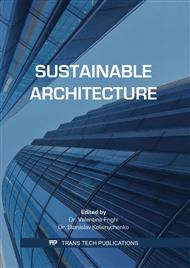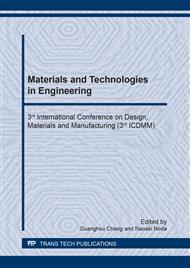[1]
S.Guy, G. Farmer: Reinterpreting sustainable architecture: the place of technology. Journal of Architectural Education 53, 3 (2001), pp.140-148.
DOI: 10.1162/10464880152632451
Google Scholar
[2]
D.Chwieduk: Towards sustainable-energy buildings. Applied Energy 76, 1-3 (2003), pp.211-217.
DOI: 10.1016/s0306-2619(03)00059-x
Google Scholar
[3]
S.Roaf, D. Chrichton, F. Nicol: Adapting buildings and cities for climate change – A 21st century survival guide, Elsevier, Oxford (2009).
Google Scholar
[4]
R.C.G.M. Loonen, M. Trčka, D.Cóstola, J.L.M. Hensen: Climate adaptive building shells: State-of-the-art and future challenges. Renewable and Sustainable Energy Reviews 25 (2013), pp.483-493.
DOI: 10.1016/j.rser.2013.04.016
Google Scholar
[5]
I.Sartori, A.Napolitano, K.Voss: Net zero energy buildings: A consistent definition framework. Energy and Buildings 48 (2012), pp.220-232.
DOI: 10.1016/j.enbuild.2012.01.032
Google Scholar
[6]
E.Fabrizio, V.Corrado, M.Filippi: A model to design and optimize multi-energy systems in buildings at the design concept stage. Renewable Energy 35, 3 (2010), pp.644-655.
DOI: 10.1016/j.renene.2009.08.012
Google Scholar
[7]
F.Favoino, Q.Jin, M. Overend: Towards an ideal adaptive glazed façade for office buildings. In: Energy Procedia 62 (2014), pp.289-98.
DOI: 10.1016/j.egypro.2014.12.390
Google Scholar
[8]
S.Parisi, D.Spallazzo, V.Ferraro, M.Ferrara, M.A. Ceconello, C.A. Garcia, and V.Rognoli: Mapping ICS Mateirals: Interactive, Connected and Smart Materials. In Proceedings of the 1st International Conference on Intelligent Human Systems Integration (2018), pp.739-744.
DOI: 10.1007/978-3-319-73888-8_114
Google Scholar
[9]
E.Giaccardi, E.Karana: Foundations of materials experience: an approach for HCI. In: Proceedings of the 33rd Annual ACM Conference on Human Factors in Computing Systems (2015), pp.2447-2456.
DOI: 10.1145/2702123.2702337
Google Scholar
[10]
J.Park, J.Yoon and K.Kim: Critical Review of the Material Criteria of Building Sustainability Assessment Tools. Sustainability 9, 186 (2017).
DOI: 10.3390/su9020186
Google Scholar
[11]
Information on http://www.breeam.com/index.jsp.
Google Scholar
[12]
Information on http://www.breeam.com/BREEAMInt2016SchemeDocument.
Google Scholar
[13]
S.Ferguson, A. Siddiqi, K.Lewis, I. De Weck: Flexible and reconfigurable systems: nomenclature and review. In: Proceedings of ASME 2007 – International design engineering technical conferences & computers and information in engineering conference (2007).
DOI: 10.1115/detc2007-35745
Google Scholar
[14]
Information on http://www.usgbc.org/resources/leed-v4-building-design-and-construction-current-version.
Google Scholar
[15]
Information on http://www.ibec.or.jp/CASBEE/english/download.htm.
Google Scholar
[16]
Information on http://www.usgbc.org/LEED.
Google Scholar
[17]
Information on http://www.ibec.or.jp/CASBEE/english.
Google Scholar
[18]
M.Addington: Contingent behaviours. Architectural Design 79, 3 (2009), pp.12-17.
Google Scholar
[19]
P.Molter, T.Wolf, M.Reifer and T.Auer: Integration of technology components in cladding systems. In: Powerskin Conference Proceedings (2017), pp.171-178.
Google Scholar
[20]
M.Ferrara, V.Rognoli, V.Arquilla and S.Parisi: Interactive, Connected, Smart materials: ICS materiality, in: Proceedings of the 1st International Conference on Intelligent Human Systems Integration (2018), pp.763-769.
DOI: 10.1007/978-3-319-73888-8_118
Google Scholar
[21]
J.E. Sabin, A.Lucia, G.Ott, S.Wang: Prototyping Interactive Nonlinear Nano-to-Micro Scaled Material Properties and Effects at the Human Scale. In Proceeding of the Symposium on Simulation for Architecture & Urban Design 2014 (2014), Article No.22.
Google Scholar
[22]
J.E. Sabin, A.Lucia, J.V.D. Spiegel, N.Engehta, K.Ihida-stansbury, P.L. Jones, S. Yang: eSkin: BioInspired Adaptive Materials, in: Labstudio: Design Research between Architecture and Biology, edited by J.E. Sabin and P.L. Jones, Routledge, New York, USA (2018), pp.313-334.
DOI: 10.4324/9781315768410-17
Google Scholar
[23]
D.K. Sung, Bloom: An Environmentally Responsive and Zero-Energy Surface System, in ACSA Faculty Design Award 2013-2014 Winner Submission Materials, Information on https://www.acsa-arch.org/docs/default-source/13-14-award-winners/fd-bloom-winners-opt.pdf?sfvrsn=0.
Google Scholar
[24]
B.Brownell and M.Swackhamer, Hypernatual: architecture's new relationship with nature, Princeton Architectural Press, New York, USA (2015).
Google Scholar
[25]
Information on https://www.buildingcentre.co.uk/case_study/icon-innovation-centre-daventry.
Google Scholar
[26]
A.Ritter, Smart materials in architecture, interior architecture and design, Birkhäuser, Basel, Switzerland (2006), pp.106-107.
Google Scholar



